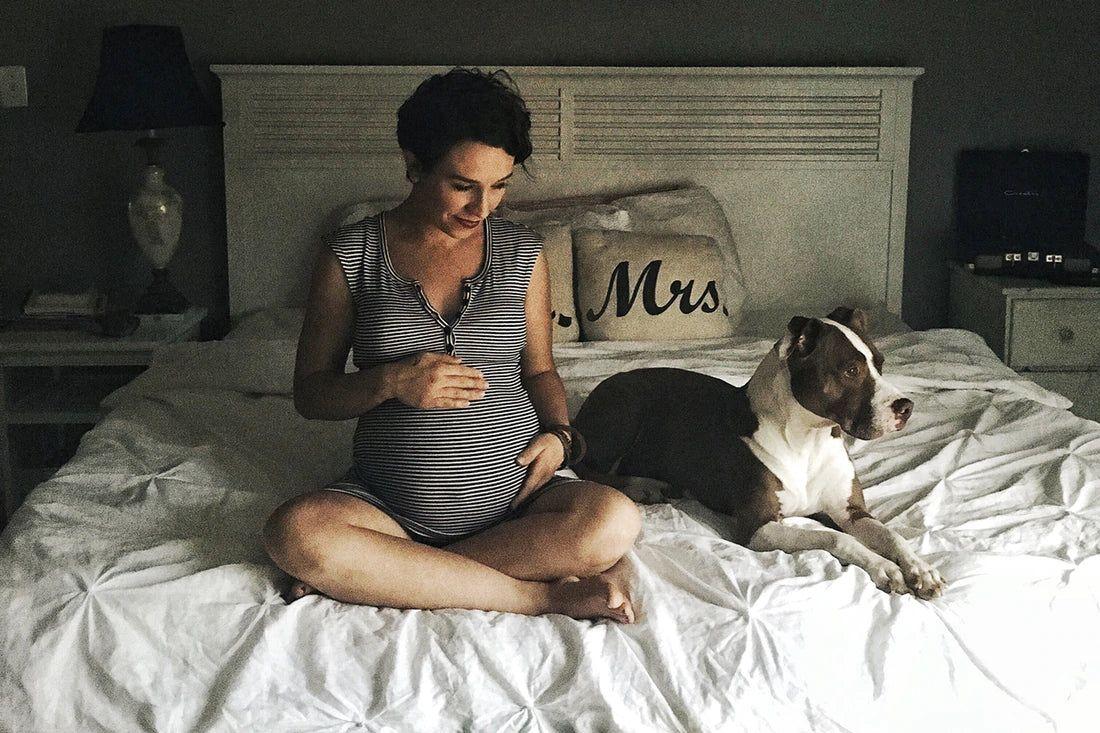PREGNANCY
12 Early Signs of Labour That Mean It is Almost Go Time
These signs and symptoms means that labour is near!

Written by
Happiest Baby Staff

SHARE THIS ARTICLE
PARENT PICKS
Bestsellers
PREGNANCY

Written by
Happiest Baby Staff

SHARE THIS ARTICLE
Bestsellers
Did you know that only 5% of pregnant women give birth on their due dates? Unless you are having a scheduled c-section, your baby’s exact birthday will be a surprise…most likely occurring between 2 weeks before and 2 weeks after your “official” due date. Though the calendar can’t give you a precise prediction, your body has many ways of dropping hints in the form of early signs of labour that let you know that the baby is on the way. Here are 12 early labour signs that the big day is coming.
Anywhere from a few weeks to a few hours before active labour begins, the baby’s head will drop into the pelvis in preparation for birth. This is called lightening. Many women first notice the drop while glancing in the mirror! Bonus: That shortness of breath you have been suffering could improve big-time as the baby shifts down, away from your diaphragm. However, you may also experience new pelvic heaviness/discomfort and increased peeing.
In the days leading up to the birth, you might get a sudden burst of energy coupled with the desire to clean, organize, or prepare for the baby. It is called nesting, and it is one of the more welcome early warning signs that labour is coming. It’s lovely to get all those little onesies folded and bottles sterilized before the big day, just don’t overdo the physical labour. (That’s what friends and family are for!)
If you have been steadily packing on kilos during the third trimester, you may notice the number on the scale stops ticking up toward the end. Some women actually lose 1 to 2 kilos due to water breaking and increased urination prior to labour.
The cervix is the thick, thumb-long connection that is the very end of your uterus. It extends a couple of inches, way up high at the innermost part of your vagina. During pregnancy, it should remain long and closed (premature opening of the cervix is a serious concern called an incompetent cervix). However, as labour nears, the cervix becomes shorter and thinner (effaced) and will begin to dilate (open). You will not necessarily feel these early changes. In fact, the first time many women know it is happening is when their healthcare provider does an exam and announces “We’re getting closer. You’re already 1-centimeter dilated!” The tricky part is that “closer” may mean hours…or a couple of weeks! When labour does come, the cervix will eventually dilate a full 10-centimeters.
Do not be surprised if one day you are full of pep and the next…you’re totally spent. The end of the third trimester can repeat this part of the first trimester…like you really need a nap! Although sleeping can be challenging when you’re 9 months pregnant, try to get rest and save your energy. Being rested will come in very handy—after all, they call it labour for a reason.
A dull ache in your back may come and go. Warm showers, going for a walk, or asking your partner to massage your lower back can help. But, if it gets increasingly worse, call your healthcare provider or midwife because that may be an early sign of labour.
A day or two before labour begins, hormones called prostaglandins go to work to help ripen your cervix (soften it so it can start to open). The downside of that is these same hormones may cause diarrhea (pregnancy sure is glamorous, is it not?). The silver lining: Emptying your bowels allows your uterus to contract more efficiently during labour. Just keep swigging water, and you’ll be fine!
Could being clumsy be a sign of labour? As labour begins, there is also an increase in the hormone relaxin, which helps widen your pelvis for birth. Relaxin affects all your joints, and that loose feeling can cause you to be clumsier than usual, so watch your step!
Your vagina may release more mucus as your body practices lubricating your birth canal, making it easier for baby to slide out when the time comes! The discharge could also be pieces of mucus breaking off from your mucus plug (more on that in a second!).
During pregnancy, your cervix is sealed shut with a plug of sticky mucus. When the cervix starts dilating, this plug starts to disintegrate and can release a thick, blood-tinged discharge a few days before labour begins. Despite its name, the bloody show should not present as bright red blood—if you see that, immediately call your provider.
Until now, you have likely been experiencing Braxton Hicks contractions, which help the body prepare for labour but do not actually dilate your cervix. Unlike true labour, Braxton Hicks contractions are irregular and unpredictable. They may be uncomfortable but are not usually painful, they are felt only in the abdomen, and you can ease them by walking or changing position. When real contractions start, they will be stronger, more frequent and will eventually come at regular intervals. Sometimes these first real labour contractions will feel like strong menstrual cramps, stomach upset, or bad back pain. And there’s nothing you can do to stop them.
When your baby is close to being born, the membranes of the amniotic sac will break releasing amniotic fluid. As the fluid passes through the cervix and out your vagina, there may be noticeable wetness, though it could be anywhere from a trickle to a gush. Most women will not experience their water breaking until after labour has begun, but for about 15%, water breaking is the trigger that brings on labour—usually within 24 hours. (Always tell your provider if you think you are leaking fluid. The opening that lets the fluid out can also let infection up into the uterus and that could have a serious effect on your baby.)
As mentioned above, there are many signs of labour that kick in well before labour begins. Generally, contractions of increasing frequency and intensity are a sign labour is starting. Start timing your contractions—how long they last, and how far apart they are. Your practitioner will want to know in order to advise you on when to head to the hospital. However, be prepared to head to the hospital immediately if you have significant bleeding or if your water breaks...and of course, do not hesitate to give your healthcare provider a ring if anything seems unusual or you’re unsure what to do.
You may see signs of labour (like the loss of your mucus plug) as far in advance as three days before labour really kicks into gear. Then, the first phase of the first stage of labour (known as the latent stage, which is before your cervix fully dilates), lasts about to 8 hours (it tends to be quicker if you have already had a baby before. Early labour will often be the longest part of the birthing process. This can last up to 3 days!
Since some of the early labour signs (like back pain) are indistinguishable from the other weird sensations of pregnancy, it is possible your body will start labour without you knowing it. However, once you notice that your contractions are getting stronger, longer, and closer together, it is time to spring into action. Likewise, your water breaking will be an undeniable sign that it is go-time!
Once you reach the final weeks of your pregnancy, you are eager to meet your little one and every new sensation may seem like a sign of labour! Though some of these signs of labour might mean you still have days—or weeks!—to go, the big day will arrive soon enough. In the meantime, you can brush up on all things babies, like this life-changing method for soothing babies.
Disclaimer: The information on our site is NOT medical advice for any specific person or condition. It is only meant as general information. If you have any medical questions and concerns about your child or yourself, please contact your health provider. Breastmilk is the best source of nutrition for babies. It is important that, in preparation for and during breastfeeding, mothers eat a healthy, balanced diet. Combined breast- and bottle-feeding in the first weeks of life may reduce the supply of a mother's breastmilk and reversing the decision not to breastfeed is difficult. If you do decide to use infant formula, you should follow instructions carefully.